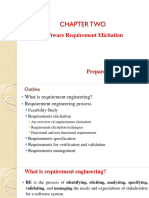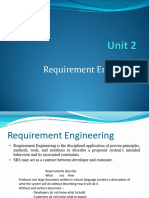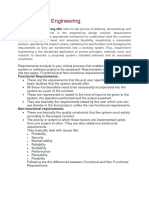0 ratings0% found this document useful (0 votes)
6 viewsChapter 3 - RE
Chapter 3 - RE
Uploaded by
kiyaehcsThe document discusses requirement elicitation including overview, concepts, activities and managing requirements elicitation. It covers topics like functional and non-functional requirements, validation, viewpoints, use case description and documenting elicitation.
Copyright:
© All Rights Reserved
Available Formats
Download as PDF, TXT or read online from Scribd
Chapter 3 - RE
Chapter 3 - RE
Uploaded by
kiyaehcs0 ratings0% found this document useful (0 votes)
6 views20 pagesThe document discusses requirement elicitation including overview, concepts, activities and managing requirements elicitation. It covers topics like functional and non-functional requirements, validation, viewpoints, use case description and documenting elicitation.
Original Title
Chapter 3 - RE (1)
Copyright
© © All Rights Reserved
Available Formats
PDF, TXT or read online from Scribd
Share this document
Did you find this document useful?
Is this content inappropriate?
The document discusses requirement elicitation including overview, concepts, activities and managing requirements elicitation. It covers topics like functional and non-functional requirements, validation, viewpoints, use case description and documenting elicitation.
Copyright:
© All Rights Reserved
Available Formats
Download as PDF, TXT or read online from Scribd
Download as pdf or txt
0 ratings0% found this document useful (0 votes)
6 views20 pagesChapter 3 - RE
Chapter 3 - RE
Uploaded by
kiyaehcsThe document discusses requirement elicitation including overview, concepts, activities and managing requirements elicitation. It covers topics like functional and non-functional requirements, validation, viewpoints, use case description and documenting elicitation.
Copyright:
© All Rights Reserved
Available Formats
Download as PDF, TXT or read online from Scribd
Download as pdf or txt
You are on page 1of 20
Software Engineering
Instructor: Mohammed Oumer[M.Sc.]
momoumer2014@gmail.com
Samara University
Chapter Three: RE
This Chapter Covers:
Overview of Requirement elicitation
Requirements elicitation concepts
Requirements elicitation activities
Managing requirements elicitation
Overview of Requirement Elicitation
Requirements elicitation and analysis involves:-
First collecting as many potential requirements as
possible.
Then refining them to form a complete, concise and
consistent set of high-quality functional and non-functional
requirements.
Then analyzing them to start forming a preliminary (the
initial) model.
Functional requirements are often modeled with the aid
of use-cases and scenarios, while the analysis step starts to
identify some of the candidate objects / classes that will be
needed in the system.
Requirements Elicitation Concepts
Functional requirements
Describe what the system should do.
They can often be derived from "stories" about how the
system will be used, which may be in the form of
scenarios, use-cases, or just a simple description of
operations.
What inputs the system should accept.
What outputs the system should produce.
What data the system should store that other systems
might use.
What computations (process) the system should perform.
Non functional Requirements
Nonfunctional requirements are properties (entity) or
characteristics (attributes) that the system must have, other
than its basic functionality.
Performance requirements
Usability – the degree of easy with w/c products such as
SW can be used to achieve required goals effectively and
efficiently.
Reliability – is the probability of failure-free SW operation
for a specified period of time in a specified environment.
Performance – an indicator of how well a SW system or
component meets its requirements for timeliness.
(timeliness – is measured in terms of response time),
response time is the time required to respond to a request.
Requirements Validation
Requirements validation is a quality assurance step,
usually performed after requirements elicitation or after
analysis.
- Completeness: All possible scenarios, in which the system
can be used are described.
- Consistency: No requirements that contradict each other.
- Clarity: Requirements can only be interpreted in one way.
- Correctness : The requirements represent the client’s
view.
- Realism: Is the requirement reasonably attainable?
Requirements can be implemented and delivered.
Requirements Validation
- Traceability : Each system behavior can be traced (find)
to a set of functional requirements.
- Verifiable / Measurable / Testable : requirements
must also be specific.
Different Types of Req`s Elicitation
Greenfield Engineering
• Development starts from scratch, no prior system
exists, requirements come from end users and clients.
• Triggered by user needs.
Re-engineering
• Re-design and/or re-implementation of an existing
system using newer technology.
• Triggered by technology enabler.
Interface Engineering
• Provision of existing services in a new environment.
• Triggered by technology enabler or new market needs.
Requirements Elicitation Activities
What is an Actor?
A role that a user plays with respect to the system, including
human users and other systems. e.g., inanimate physical
objects (e.g. robot).
Include all user roles that interact with the system.
Include system components only if they responsible for
initiating/triggering a use case.
ATM Stakeholders
Stackholders – defined as an individual or group that has an
interest in any decision or activity of an organization.
Bank customers – Someone who access bank.
Bank managers – A person who directs the business.
Database administrators – The information technician
responsible for directing or performing all activities
related to bank.
Security staff – A team whose job is to protect money.
HW and SW maintenance engineers – Fixing bugs and
errors related to SW and HW devices.
Banking regulators – provide charters (written
document) to banks operating.
Viewpoints
Viewpoints are a way of structuring (organizing) the
requirements to represent the perspectives of different
stakeholders. Stakeholders may be classified under different
viewpoints.
This multi-perspective analysis is important as there is no
single correct way to analyze system requirements.
Types of viewpoint
Interactor viewpoints
People or other systems that interact directly with the
system. In an ATM, the customer’s and the account
database are interactor VPs.
Indirect viewpoints
Stakeholders who do not use the system themselves but
who influence the requirements. In an ATM, management
and security staff are indirect viewpoints.
Domain viewpoints
Domain characteristics and constraints that influence the
requirements. In an ATM, an example would be standards
for inter-bank communications (relating to transaction or
communication between banks).
Viewpoint Identification
Identify viewpoints using :-
Providers and receivers of system services.
Systems that interact directly with the system being
specified.
Regulations and standards.
Engineers who have to develop and maintain the system.
Order of Steps when Formulating US
First step: name the use case with verb phrase.
Use case name: Deposit money
Second step: Find the actors.
Participating Actors: Branch officer etc…
Third step: Then concentrate on the flow of events.
Use informal natural language.
Use case Description
Use case name: Deposit money
Use case ID: UC6
Actor: Branch officer
Description: is activated (switch on) when the customer
wants to deposit money.
Pre-condition: user must be login to the system and the
customer should have an account.
Basic flow of events:
1. The branch officer chooses the core banking link.
2. Then the branch officer chooses the deposit link.
3. fill the deposit form.
4. Click on deposit button.
Cont.
5. The system verifies that the deposit form was filled
correctly.
6. The system displays ” successfully deposited
notification”.
7. Use case ends.
Alternative flow: A system unable to deposit money.
A-5. The system verified that the user filled the
information incorrectly.
A-6. The system displays an error message that shows
the user filled the form incorrectly.
A-7. Use case resume from step 3 of main flow of events.
Post condition: The system displays “successfully
message” and update the customer’s account balance.
Managing Requirements Elicitation
Requirements management is the process of managing
changing requirements during the requirements
engineering process and system development.
Requirements are inevitably (can not be avoided)
incomplete and inconsistent.
New requirements emerge during the process as
business needs change and a better understanding of
the system is developed.
Different viewpoints have different requirements and
these are often contradictory.
Requirements Change Management
Should apply to all proposed changes to the requirements.
Principal stages :-
Problem analysis. Discuss requirements problem and
propose change.
Change analysis and costing. Assess (evaluate) effects
of change on other requirements.
Change implementation. Modify requirements
document and other documents to reflect change.
Documenting Req`s Elicitation
The results of the requirements elicitation activity and
the analysis activity are documented in the Requirements
Analysis Document (RAD).
This document completely describes the system in terms of
functional and nonfunctional requirements and serves as a
contractual basis between the client and the developers.
The audience for the RAD includes the client, the users, the
project management, the system analysts.
The first part of the document, including use cases and
nonfunctional requirements, is written during requirements
elicitation.
Thank You ...
You might also like
- Chapter Five and Six Answer PDFDocument3 pagesChapter Five and Six Answer PDFrhealyn ramadaNo ratings yet
- Requirements Analysis & Requirements SpecificationDocument28 pagesRequirements Analysis & Requirements SpecificationRohini Rowx100% (2)
- Pestel AnalysisDocument8 pagesPestel AnalysisLaurice CabreraNo ratings yet
- Economics Higher Level Paper 3: Instructions To CandidatesDocument20 pagesEconomics Higher Level Paper 3: Instructions To CandidatesAndres LopezNo ratings yet
- Information Gathering: Interactive Methods: SummaryDocument12 pagesInformation Gathering: Interactive Methods: SummaryEmerighon CagubcobNo ratings yet
- Ch.3.requirements AnalysisDocument22 pagesCh.3.requirements AnalysisAnuj NikamNo ratings yet
- Abdulwadood Assignment 2Document11 pagesAbdulwadood Assignment 2Abdulwadood ZawityNo ratings yet
- Software Engineering CS508: SectionsDocument30 pagesSoftware Engineering CS508: SectionsMohamed Abdel-AzizNo ratings yet
- Srs and AnalysisDocument7 pagesSrs and AnalysisPuneet JangidNo ratings yet
- 1b Requirements EngineeringDocument49 pages1b Requirements EngineeringpnaronaNo ratings yet
- User and System ReqDocument26 pagesUser and System ReqjeniyazhiniNo ratings yet
- Unit 3: Requirements Engineering ProcessesDocument4 pagesUnit 3: Requirements Engineering ProcessesLokesh KCNo ratings yet
- By Khadak Budha Chhetri: Unit .2 Software RequirementsDocument7 pagesBy Khadak Budha Chhetri: Unit .2 Software RequirementskhadakNo ratings yet
- Requirements Engineering - Introduction (Part 1)Document7 pagesRequirements Engineering - Introduction (Part 1)MubeenNo ratings yet
- It InternationDocument45 pagesIt Internationramjk286No ratings yet
- Notes of Unit - II (SE) - 1Document60 pagesNotes of Unit - II (SE) - 1Ujjwal GuptaNo ratings yet
- CH 3 SAD SolutionsDocument44 pagesCH 3 SAD Solutionsnoluthandombeje0No ratings yet
- Se IaDocument19 pagesSe Iayashas patilNo ratings yet
- Software Engineering NotesDocument4 pagesSoftware Engineering NotesHarsh RathoreNo ratings yet
- Requirements EngineeringDocument5 pagesRequirements EngineeringMaricar SucalditoNo ratings yet
- Lecture - 7Document29 pagesLecture - 7lashya.ponkumarNo ratings yet
- Modeling Requirements With Use CasesDocument80 pagesModeling Requirements With Use Caseskickerzz04No ratings yet
- 6ed Solutions Chap03Document22 pages6ed Solutions Chap03JesseSpero50% (2)
- Collecting and Analysing: Software RequirementsDocument17 pagesCollecting and Analysing: Software RequirementsBakanjim BarbNo ratings yet
- ReqengDocument42 pagesReqengrakeshlonari4042No ratings yet
- Investigating System RequirementsDocument58 pagesInvestigating System RequirementsBALAMU MBUZWENo ratings yet
- Bank Customer Mangaement SystemDocument10 pagesBank Customer Mangaement SystemAliv GhoshNo ratings yet
- Lecture 7 - Requirements EngineeringDocument20 pagesLecture 7 - Requirements EngineeringAamerMAhmad100% (1)
- 2.software Requirements EngineeringDocument7 pages2.software Requirements EngineeringSANTOSH4176No ratings yet
- Useful Use Case Tips & Techniques: Developed For PDS2011 Brenda BoonDocument58 pagesUseful Use Case Tips & Techniques: Developed For PDS2011 Brenda BoonDaBlackIceNo ratings yet
- Requ Chapter 3Document15 pagesRequ Chapter 3noveyis180No ratings yet
- Chapter 3Document26 pagesChapter 3Jiru AlemayehuNo ratings yet
- Unit - II Oose FinalDocument46 pagesUnit - II Oose Finalrakshithaashok247No ratings yet
- Week 2 & 3Document49 pagesWeek 2 & 3WardaddyNo ratings yet
- Ssad Chap 4Document85 pagesSsad Chap 4Ziyad MohammedNo ratings yet
- Chapter 4. Requirement EngineeringDocument62 pagesChapter 4. Requirement Engineeringsukhmanaulakh54No ratings yet
- Comp 468 Lecture Slide Chapter 02 (Software Requirement Elicitation)Document32 pagesComp 468 Lecture Slide Chapter 02 (Software Requirement Elicitation)donmitchell45No ratings yet
- Banking SysytemDocument5 pagesBanking SysytemEugene KiliwaNo ratings yet
- SWE LastDocument8 pagesSWE Lastalmuhtarif.egyptian.yahoo.comNo ratings yet
- Requirements Engineering in Software DevelopmentDocument38 pagesRequirements Engineering in Software DevelopmentJimmeyNo ratings yet
- Unit 2Document104 pagesUnit 2Mayank PurohitNo ratings yet
- Chapter Three PDFDocument31 pagesChapter Three PDFbetyNo ratings yet
- Budget Approval SystemDocument7 pagesBudget Approval SystemAnuj GuptaNo ratings yet
- Chapter 3 RevisionDocument10 pagesChapter 3 Revisiontaariqc2000No ratings yet
- OOSE Module 2 Complete SolutionsDocument39 pagesOOSE Module 2 Complete SolutionsDinesh ReddyNo ratings yet
- SE Module2Document35 pagesSE Module2116TanzeelNo ratings yet
- CSE204 - Software RequirementsDocument14 pagesCSE204 - Software RequirementsjafarshehusaniNo ratings yet
- Unit2 Requirements EnggDocument7 pagesUnit2 Requirements EnggmukundsinghkushwahaNo ratings yet
- 4 UnitDocument15 pages4 Unitkanaiya valviNo ratings yet
- Online ShoppingDocument10 pagesOnline ShoppingPrabhjot KhehraNo ratings yet
- Object-Oriented: Analysis and DesignDocument27 pagesObject-Oriented: Analysis and DesignNakashima AkiraNo ratings yet
- Software Engineering Micro ProjectDocument49 pagesSoftware Engineering Micro Projectsakshi100% (1)
- 3CS4-07 U3 L1-L7 by MR - Gendal LalDocument48 pages3CS4-07 U3 L1-L7 by MR - Gendal LalsavitasainstarNo ratings yet
- Analysis Concepts and Principles: Software Requirements EngineeringDocument9 pagesAnalysis Concepts and Principles: Software Requirements EngineeringAro PreethiNo ratings yet
- Hospital Management SystemDocument4 pagesHospital Management Systemirfan_chand_mianNo ratings yet
- 03 RE ProcessDocument32 pages03 RE ProcessmanarkhaliidxNo ratings yet
- Requirement GatheringDocument11 pagesRequirement GatheringHira FarooqNo ratings yet
- System Analysis and Design August 3 2023Document9 pagesSystem Analysis and Design August 3 2023Sam GallineroNo ratings yet
- Instant Ebooks Textbook Services Marketing Concepts Strategies Cases 6e 6th Edition K. Douglas Hoffman Download All ChaptersDocument84 pagesInstant Ebooks Textbook Services Marketing Concepts Strategies Cases 6e 6th Edition K. Douglas Hoffman Download All Chaptersgyuroompox100% (1)
- Pestle Analysis of MauritiusDocument38 pagesPestle Analysis of Mauritiusmerchantraza140% (4)
- VII RebookingDocument2 pagesVII Rebookingarpit raghavNo ratings yet
- FR 006 Part Submission Warrant PSWDocument1 pageFR 006 Part Submission Warrant PSWJesus AguilarNo ratings yet
- IPCC Chapter Topic Wise Analysis of Past Exam Papers PDFDocument133 pagesIPCC Chapter Topic Wise Analysis of Past Exam Papers PDFKansal Abhishek73% (15)
- Objectives and Instruments of Monetary Policy in An Islamic EconomyDocument3 pagesObjectives and Instruments of Monetary Policy in An Islamic EconomyBilal Rafaqat TanoliNo ratings yet
- 1Q23 Supporting SpreadsheetDocument22 pages1Q23 Supporting SpreadsheetJamilly PaivaNo ratings yet
- Wah Simple Training - PetronasDocument15 pagesWah Simple Training - PetronasHaika Danial100% (1)
- PT MSM TBK 30 Sept 2022 KONSOL - Q3 PDFDocument67 pagesPT MSM TBK 30 Sept 2022 KONSOL - Q3 PDFandry4jcNo ratings yet
- Chapter 2 Ky 22021 HandoutsDocument69 pagesChapter 2 Ky 22021 HandoutsKhánh HòaNo ratings yet
- Faktor-Faktor Yang Mempengaruhi Kualitas Laporan Keuangan Pemerintah Daerah Di Kabupaten Kepulauan TalaudDocument12 pagesFaktor-Faktor Yang Mempengaruhi Kualitas Laporan Keuangan Pemerintah Daerah Di Kabupaten Kepulauan TalaudfaldyNo ratings yet
- Spontaneous CombustionDocument10 pagesSpontaneous Combustionsaira tahirNo ratings yet
- Negotiation Practice On Book Publishing - Nedwin - CourseraDocument2 pagesNegotiation Practice On Book Publishing - Nedwin - CourseraedwinNo ratings yet
- Philippine Stock Exchange: Head, Disclosure DepartmentDocument8 pagesPhilippine Stock Exchange: Head, Disclosure DepartmentPaulNo ratings yet
- Happy Meal AnalogyDocument3 pagesHappy Meal AnalogyPurple KimVNo ratings yet
- User ResearchDocument21 pagesUser Researchfabulous oyedunNo ratings yet
- Session 06-WTC PPT (Feb 11, 2019)Document25 pagesSession 06-WTC PPT (Feb 11, 2019)MtashuNo ratings yet
- Kehkashan Ansari: Career ObjectiveDocument2 pagesKehkashan Ansari: Career ObjectiveHasan AhmedNo ratings yet
- ClientDocument12 pagesClientMadhusudan Kapal0% (1)
- Entrepreneurship: Scope, Importance and ObjectiveDocument17 pagesEntrepreneurship: Scope, Importance and Objectiveartee_aggrawal4312No ratings yet
- VFR 4 Final 021419Document136 pagesVFR 4 Final 021419Trader CatNo ratings yet
- 008 Supply and Delivery of Grocery ItemsDocument6 pages008 Supply and Delivery of Grocery Itemsaldrin pabilonaNo ratings yet
- Tool Changers - End-of-Arm Tooling - Vacuum ProductsDocument20 pagesTool Changers - End-of-Arm Tooling - Vacuum ProductsDiego ProtonNo ratings yet
- Financial Statement Presentation Guide (Document819 pagesFinancial Statement Presentation Guide (bla csdcd100% (1)
- Mba Report On A Training CenterDocument40 pagesMba Report On A Training CenterParitoshNo ratings yet
- Wa0001 PDFDocument298 pagesWa0001 PDFZohair HumayunNo ratings yet
- Rules For References ResumeDocument8 pagesRules For References Resumegqtdmdrmd100% (1)
- ESR Project Brochure Lodha PalavaDocument30 pagesESR Project Brochure Lodha PalavaJash ShahNo ratings yet

























































































